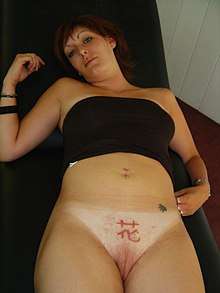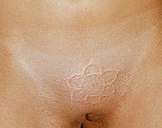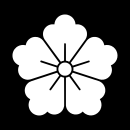Hanabira

Hanabira (花弁) is a form of scarification originating in Japan. It involves the decorative scarring of the mons pubis. The term means petal in Japanese language and refers to the commons floral patterns of traditional monshō.
Background
Concluding from various archaeological and artistic evidence, genital scarification in men and women has been practiced since the Upper Palaeolithic period.[1] The Hanabira scarification was potentially introduced in the Japanese body modification culture and has only recently become popular in western countries.[2][3][4] While the emblem can be a very personal sign and identity symbol in Japan, the western adoption in usually done for purely aesthetical reasons.
Style


The form of the scar is often inspired by traditional monshō (紋章) or mondokoro (紋所), decorative emblems or symbols that identify a person and are unique for that individual or its family.[4] Most monshōs are monochrome and show the stylized representation of a plant, oftentimes floral elements, or an animal in an edged circle. (see: Gallery of representative kamon «monshō» by theme) Hanabira may also take the form of stylized Kanji (漢字).
Method
The desired patterns or lettering are cut into the skin with a scalpel. To keep the incisions from simply growing together, wound healing is intentionally delayed so that a visible scar develops after some time.[5][2]
See also
References
- ↑ Angulo, Javier C., Marcos García-Díez, and Marc Martínez. "Phallic decoration in paleolithic art: genital scarification, piercing and tattoos." The Journal of urology 186.6 (2011): 2498-2503. doi:10.1016/j.juro.2011.07.077
- 1 2 Schnittiger Trend? Scarification statt Tattoo - Stylight
- ↑ Narben, Narbenbildung, Narbenentfernung, Skarifizierung - Narben
- 1 2 Abendroth, A. (2009). Bodymodification. Körpermodifikationen im Wandel der Zeit. Tattoos, Piercings, Scarifications. ISBN 9783866081123
- ↑ Cutting Tattoos: Ziernarben statt Tinte - Desired